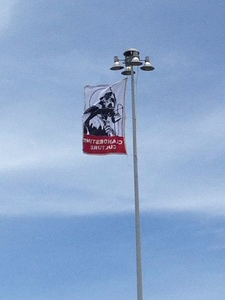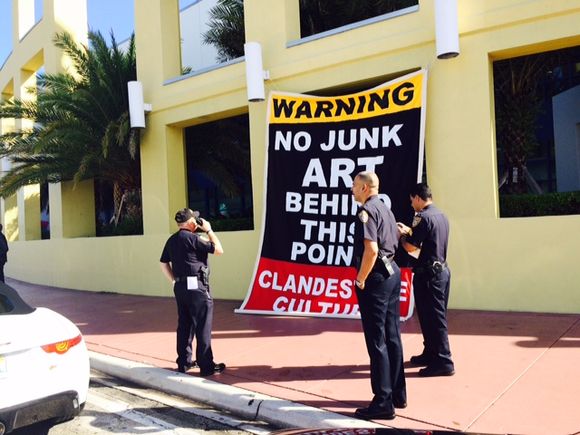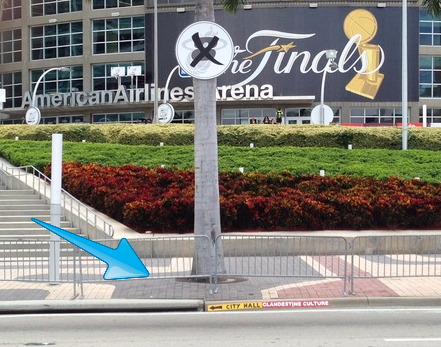|
CLANDESTINE CULTURE
Isis Drinks Pepsi
2016
Acrylic on wood
45 x 71 1/2 in.
Signed on verso
About This Work:
For some years now, the streets of Miami have been covered with enormous posters bearing the CLANDESTINE CULTURE hallmark. They are works that stand out not only because of the anti-establishment message implicit in them, but also due to their artistic quality.
CLANDESTINE CULTURE is an American contemporary artist working in Miami who, despite his fame, has maintained anonymity.
CLANDESTINE CULTURE was born in 1970 and moved to Miami in the early 1990’s. By the year 2000 he started working as a urban artist and in 2012 he had his first solo gallery exhibition.
His work acts as visual cultural criticism and commentary, with established social and political agendas serving as targets for a unique style of illustration made using several different media, such us canvas, neon and banners.
His art production is s diversified in different formats from painting and sculpture to street art installations and it is often characterized by large format works on paper, that use wheatpaste applications on urban buildings. The works have CLANDESTINE CULTURE written within the work.
Known it for his strong social criticism and portrayal of taboo subjects, that sometimes can appear disturbing, no one can deny the controversial characteristics of his work.
On July 20, 2013, one of his most important projects, The Banner Project, started.
The concept of the project was to raise or hang flags around the city of Miami as art installations. The first flag was raised illegally over Julia Tuttle Causeway on a street light, property of the State Of Florida. The size of the banner was 10 x 16 feet, made of synthetic fabric and painted with latex paint, featuring a black and white image of a police in riot gear, with a red CLANDESTINE CULTURE sign painted at the bottom. This flag was raised on a High-mast lighting, at a height of 98 feet. The method used to raise the flag has never been revealed. The waving flag remained for five days, until it was removed by the Florida Highway Patrol.
  
The flag on Julia Tattle Causeway, Miami – July 20th, 2013.
By the summer of 2014 another The Banner Project took place, this time in the Miami Marine Stadium. The size and materials were similar to the one used on the Julia Tuttle Causeway.
Approaching December of the same year, Culture acted again, on this occasion in front of the Miami Beach Convention Center, during Art Basel Miami Beach 2014.
Since then no other flag has been placed in the area of Miami.

The police removing the banner at the Miami Beach Convention Center, Art Basel Miami 2014
Many other “street pranks” have occurred. For example, during the NBA Finals in 2013 Miami Heat vs San Antonio Spurs, CLANDESTINE CULTURE placed a sign that read “CITY HALL” and has arrows pointing to the sewer in the street.

The CITY HALL sign next to the sewer placed by the street artist during the NBA Finals, American Airlines Arena, Miami 2013
As for the name, the artist explains: “When I first wrote this phrase on the street six years ago, it was very personal, I was not happy with my life and the way society treated me. It seemed as if ‘they’ thought they were right and I was wrong. ‘They’ always told the truth and you had to obey them. ‘They’ never asked how do you feel, or if you agree with what ‘they’ are suggesting. ‘They’ are always correcting you. One night I was walking on the street by a commercial area close to my neighborhood. I passed by a big garbage container. I stopped, and with an oil stick I wrote, “I’M CLANDESTINE CULTURE. WELCOME TO MY WORLD.” I did not know why I did it, I just did it and it worked. I was feeling better after that. I released all my anger and all my frustration in just one phrase: CLANDESTINE CULTURE“.
Still today, the artist chooses to remain anonymous. He hits the street with his face and head completely covered. He believes that the painting and the message is more important then the artist. He uses the faces of everyday people, images and words, to show that in the end, we the people are all part of one world wide culture… a clandestine culture.
|